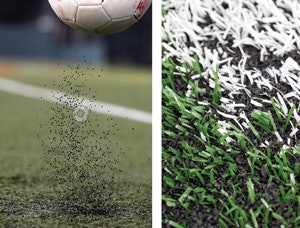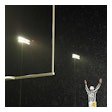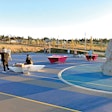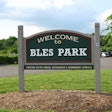The turf revolution started at the Houston Astrodome in 1966 with Major League Baseball's first synthetic turf field. The original AstroTurf — developed when glare reduction became more important than the ability to grow natural grass within the dome — did for the athletics industry what the original Apple I did for the computer industry, and it's now just as outdated as an original Apple I.
"The original knit-nylon AstroTurf came out in the late '60s, and it caused a lot of rug burn," says John Sorochan, University of Tennessee turfgrass professor and founder of the Center for Athletic Field Safety. "It was basically an indoor/outdoor carpet with a foam pad over concrete."
The development of synthetic turf was pioneered by three primary brands: Monsanto's AstroTurf; 3M's Tartan Turf and American Built-Right's Poly-Turf. Since then, other manufacturers have come and gone. Even the AstroTurf brand has changed hands several times, most recently being acquired by SportGroup of Germany.
As the performance and safety of synthetic turf has improved, its appeal has grown beyond professional baseball. Today, the Synthetic Turf Council estimates that there are between 12,000 and 13,000 synthetic turf fields in the United States used for baseball, football, soccer, field hockey and other field sports at public parks, schools, colleges and more.
![AstroTurf installed at the Astrodome in July 1966 [Photo courtesy of chron.com]](https://img.athleticbusiness.com/files/base/abmedia/all/image/2017/04/ab.turf1_417.png?auto=format%2Ccompress&fit=max&q=70&w=400) AstroTurf installed at the Astrodome in July 1966 [Photo courtesy of chron.com]
AstroTurf installed at the Astrodome in July 1966 [Photo courtesy of chron.com]
Advancements in core components
Synthetic turf is often categorized into generations, starting with the carpet-and-pad AstroTurf system. "We had original AstroTurf and then OmniGrass, which was an all-sand infill system, and then there was the FieldTurf model," says Andrew McNitt, director of the Sports Surface Research Center at Penn State.
The addition of silica-sand infill with products such as OmniGrass was a vast improvement. Though it enjoyed middling success in Europe, this second generation of turf was still too hard for the aggressive nature of American football and did not gain much traction in the United States.
The next significant advancement in synthetic turf came in the 1990s, when companies swapped some or all of the sand infill with crumb rubber. "The average person calls it a FieldTurf," Sorochan says. "They've become the Kleenex or Band-Aid of synthetic turf. They have a big market share in North America, but a lot of the other companies do a lot of fields worldwide."
Infill variations today include everything from crumb rubber to coconut fiber, and the list continues to expand, though there's no clear "fourth-generation" just yet. "We'll continue to see other infill options," says David Nardone, leader of the Boston-based sports group for architecture firm Stantec. "Half a dozen hit the market last year, and we'll see more this year. We need to see those fields in the ground to see which will be long-lasting options and what the users are going to gravitate toward."
Beyond the infill options, the synthetic fibers that make up the "blades" of the field have also improved, offering better performance and durability. "We went through a period when manufacturers were pushing monofilament, but slit-film has proven itself from a safety and maintenance standpoint," Nardone says.
Moreover, as demand for synthetic turf has expanded to other field sports, specialized systems have been created to meet the differing needs of each, with different fiber shapes and textures — for example, the fast pace of play makes older, flatter field models the preferred choice for field hockey.
"If you look back 10 years ago at turf manufacturers' websites, you would have found one or two systems available," Nardone says. "If you look at any of the big companies today, you're going to find a half dozen or a dozen. Some are geared more toward soccer or rugby."
ISSUES SHAPING FUTURE TURF SYSTEMS
Surface hardness
One of the major problems with the first generation of synthetic turf was its lack of resilience, quantified using a G-max rating. Fields that are too hard increase the risk of concussion and injury, but fields that are too soft hamper performance. In 2011, the NFL started requiring field-hardness tests prior to each game. "We didn't have an extensive set of data prior to 2011 when we instituted this, but we had data from five or six fields," says McNitt, part of the team that developed the certification criteria. "We've lowered the surface hardness on average by almost 30 percent. With that and the rule changes, until last year there was a pretty steady decline in concussions."
Infill material and depth are the primary factors impacting a field's G-max rating, which can steadily degrade. "People think that synthetic turf gets hard over time because it becomes compacted," McNitt says. "It's not that. There are two main drivers: walk-off crumb rubber — it gets in your shoes and leaves the field slowly over time — and paint buildup. In the NFL we suggest no more than four paintings and then you have to extract the paint."
The latter problem is becoming easier to solve as paint companies improve their formulas and use of paint-removal devices becomes more common. As for walk-off crumb rubber, McNitt advocates regular monitoring. "What I suggest people do, especially on a new field, is get the crumb rubber depth from the manufacturer. There's a simple tool that you can buy, and then you walk around the field and monitor depth."
Many programs also go with the added security of a shock pad under the field. "If you put down a safety pad first and then an infill carpet on top of that, you have two different resilient systems working together," Nardone says.
Shock pads also act as something of an insurance system when maintenance standards aren't properly followed, says Sorochan. "The shock pad keeps the field from getting too hard and helps maintain a more-consistent surface."
Heat
"Heat is still a big issue," McNitt says, noting the drastic difference between temperatures on clear, sunny days versus cloudy or hazy days. "On sunny days, the temperature three feet above the surface is only slightly warmer, but the surface itself is very hot. It's enough that it goes through the shoes into the foot and the player has to dissipate that heat."
Solutions range from use of irrigation to cool down the field to different colors or mixtures of infill. To date, no product has proven to be a panacea. "Heat continues to be the biggest negative of synthetic turf," Nardone says. "We're going to see more options, and there is research going on into how we can mitigate the heat. Additives to the fiber have shown promise — heat-reflector in the fiber helps a little bit but isn't the full answer."

Crumb rubber
Recent media attention has renewed the controversy over the potential health risks of crumb rubber in turf systems that utilize recycled car tires, prompting the EPA to call for a new review in 2016. McNitt and other turf specialists continue to urge consumers not to jump to conclusions. "People get worried about things, but they don't understand what's going on," McNitt says. "Toxicology is not a big concern for me. To date, I can't find any research that corroborates that there's any toxicology issue."
"People need to ask questions and listen and look at the data available," Nardone says. "Think about the crumb rubber infill — it's in our environment everywhere. If it was an issue in an athletic field, we would have a much larger issue in our overall environment."
 Athletic Business turf ads through the years -- Click to see more
Athletic Business turf ads through the years -- Click to see more
Consumer awareness
Whatever the verdict on crumb rubber, one good thing that has come of the controversy is that it's driven more owners to take an interest in their fields. "They're asking questions about the systems, the infill," Nardone says. "A lot of folks want to make sure they make a good decision."
"The awareness has been brought about with crumb rubber more than anything," Sorochan agrees. "The biggest problem with athletic turf in this country is that fields are sold or bought with the idea that they don't require maintenance. That's one of the biggest downfalls for the life of these fields and the playability."
Those misconceptions are now being fended off early in the process. "We'll make sure they meet with the vendor, talk with different manufacturers that have different ideas around maintenance," Nardone says. "It's a good discussion, and it doesn't happen in one day. They'll call for staff training in the specifications from the manufacturer or installer. Because it comes down to the user, the sport, the institution, there are nuances that you might be doing to your field that the guy down the street isn't doing to his field."
Sustainability
The advertised lifespan of a synthetic turf field is typically eight years, at which point some or all components need to be replaced. As more communities invest in fields, the demand for a sustainable option for end-of-life disposal has increased. "Unfortunately, the market for recycling hasn't grown as fast as we'd like," Nardone says, noting that current options to recycle involve shipping the materials overseas. "There's a very good option in Asia," he says, provided transport is feasible. "You can coordinate easily to have containers dropped off at the site, pack the turf and ship it off."
The Synthetic Turf Council launched a Recycle and Reuse Task Force in 2016 to help divert the components of fields from ending up in landfills and offers a set of guidelines for removal, recovery and reuse.
Nardone also notes that shock pads can play a role in sustainability. "You can put in less infill if you have a robust safety pad," he says. "If you're putting in less infill, when it comes time to replace and recycle, you have less material that you're trucking in and out."
Beyond the surface
Though there's plenty more to be done on the fields themselves, research is also being conducted on the gear athletes wear, specifically footwear, when competing on synthetic turf. "While surfaces play a role, the shoes are an important part. Shoe selection creates more variation than the surfaces out there, at least in the NFL," says McNitt, noting that PSU keeps a database of shoe types to help coaches, athletes and trainers pick the best shoes for their sport. "Traditionally, people haven't thought of shoes as a piece of protective equipment," he adds. "We're trying to change that perception. We think that's low-hanging fruit and one of the quickest, most impactful things we can do to minimize lower-extremity injuries."
In addition to footwear, researchers are also revisiting the decades-old methods used to evaluate field performance. "Many of the testing devices we use today were developed back then," Sorochan says, noting that his team has about a dozen research projects currently underway. "A Clegg hammer test for surface hardness, for example, doesn't tell us anything about human impact, yet we use that as a standard. We're looking at head impact criteria, bringing in human test subjects — outfitting them with motion-capture systems to look at their avatars and find out how different it is from one surface to another."
This article originally appeared in the April 2017 issue of Athletic Business with the title "Great strides taken during the synthetic turf revolution." Athletic Business is a free magazine for professionals in the athletic, fitness and recreation industry. Click here to subscribe.
































